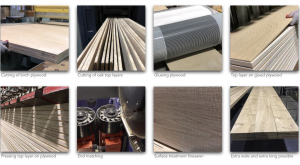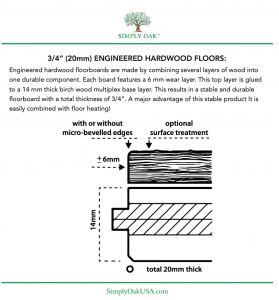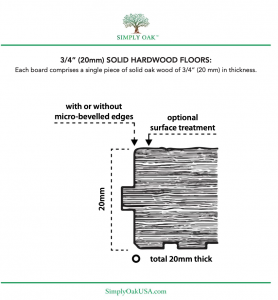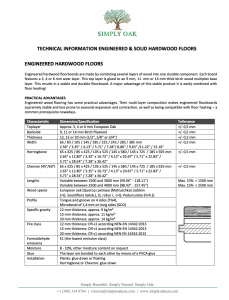- Engineered wood flooring has some practical advantages. Their multi-layer composition makes engineered floorboards supremely stable and less prone to seasonal expansion and contraction, as well as being compatible with floor heating – a common prerequisite nowadays.
- Engineered European White Oak is more sustainable as we are using less of the real material. We get so much more yield from the tree than if we produce a Solid Board – we have a full 6mm wear layer on our 3/4″ (20mm) Engineered boards and a 4mm wear layer on our 5/8″ (15mm) Engineered boards.
- Engineered material generally requires less time to acclimate to the environment in the field verses a Solid material, this can be a huge benefit, especially if the builder is on a tight construction schedule. Moisture acclimation is NOT a function of time.
- Engineered floors are constructed in such a way that they have enhanced stability against buckling, though Solid and Engineered floors are extremely durable and capable of withstanding harsh treatment. Engineered wood is dimensionally more stable compared to Solid wood floors.
- Expansion and contraction – The distinct construction of engineered wood forms a rigid structure that does not gap, buckle, or respond to fluctuations in temperature and humidity. Solid wood fluctuates a lot, and is mostly used for ground level rooms and above, while Engineered wood can be installed on any level, including below ground.
- Stability – Engineered wood is dimensionally more stable compared to Solid wood floors.
- Cost – Solid hardwood is generally more expensive than an Engineered floor.
- Resistance to moisture – Compared to Solid hardwood, Engineered wood floors have superior resistance to slightly lower and higher moisture levels, which makes them more ideal for use in damp basements or regions with higher or lower than standard humidity levels.
- “Going Green“ – By choosing Engineered floors over Solid wood floors helps to conserve timber. For every 1 square foot of ¾ inch thick solid wood floor, you can manufacture around 4 times that amount into Engineered wood flooring.
- Engineered wood is a layered product made of an actual slice of hardwood on top of a base of high-quality plywood. We use layers of Russian Birch Plywood which are stuck perpendicular to each other.
- Installation – Engineered wood is easier than solid hardwood as you have a greater range of installation methods, including stapling or nailing, fold-and-lock, or glue.
- Because Engineered wood floors are “Real” wood, they can be advertised as such in real estate marketing materials, making them more attractive to buyers.
- Moisture – Engineered wood is better than solid hardwood at dealing with moisture. Its plywood base is dimensionally stable, meaning that it warps and flexes less easily upon contact with moisture than Solid wood. Fibers in plywood run in cross-wise layers, a far more stable structure than Solid wood’s parallel fibers.
- Should you buy it – Engineered wood is for those who want the look of wood. Engineered wood lets you install it in a few more rooms of the house than you can with solid wood.
- Engineered hardwood flooring does not always require a plywood subfloor. This means if you have a concrete subfloor, you can install the material directly over the concrete as long as the concrete is a minimum of 60 days pour and no longer GREEN (meaning it is dry).
SIMPLY BEAUTIFUL. SIMPLY NATURAL. SIMPLY OAK.




